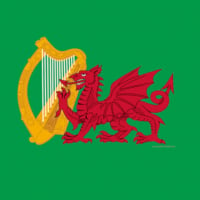Multiple (7) townlands identified as Johnstown, County Meath, Ireland. And others.

These are proof (if anybody was in any doubt) that you need to include an extra level of place below county when you create a townland.
https://www.logainm.ie/en/s?txt=johnstown
Also 3 "Johnstown, County Wexford, Ireland" in your database that need to be distinguished. Same logainm.ie link as above.
Those are just the ones I found while checking for missing townlands in Kilgullane (civil parish), County Cork, Ireland, so there'll be many more.
To confuse the matter, another thing that I've only just realized from looking at loagainm.ie is that the next level up from townland can be either civil parish or electoral division, which bear no relation to each other.
So what is the general policy on this ? Being pragmatic, having townlands directly below counties is probably okay if there's only one townland of that name in the county. But if there's two or more you need to distinguish them by including either a (civil) parish or ED/DED - it probably doesn't matter which, as long as it's clearly specified.
Comments
-
Another source to show multiple townlands of the same name in the same county is the General alphabetical index to townlands and towns, parishes and baronies of Ireland taken from the 1851 census. See URL https://www.dippam.ac.uk/eppi/documents/14424/pages/373211 for the lists of Johnstowns, including 8 in Co. Meath.
My understanding of best practice for rural locations in Ireland - which is what Townlands are - is that the hierarchy is
- Townland
- Civil Parish
- County
- Ireland
I have never seen townlands recorded in genealogy with ED/DED as the next level up. That doesn't mean you won't see a document with that on, rather that best practice is to find out what the civil parish is, and use that.
In truth, you will find lots of places advise a 5-level hierarchy of
- Townland
- Civil Parish
- Barony
- County
- Ireland
However, many people (including myself) find that the Barony causes as many problems as it solves. For instance (just looking at the parish), one table might tell you that there are two civil parishes called Kilruane in County Tipperary, viz;
- Kilruane
- Lower Ormond
- Co. Tipperary
- Ireland
and
- Kilruane
- Upper Ormond
- Co. Tipperary
- Ireland
(This is a real example). However, if you look at the map, what happens is that the boundary between the 2 baronies of Upper and Lower Ormond goes "off-piste" and cuts through the civil parish of Kilruane, as it's not a strict hierarchy.
To make life really "interesting" there genuinely are cases of two different civil parishes of the same name in a county. For instance, Co. Tipperary has two parishes called Ballingarry - one in the barony of Lower Ormond, and another in the barony of Slievardagh. In such cases, one possible way is to record the civil parishes as "Ballingarry (Lower Ormond)" and "Ballingarry (Slievardagh)". Add in cases where Anglo-Saxons like myself mangle spelling of Irish names to increase duplicates...
1 -
I am working on this. You are correct, we do need another level. Here are the guidlines for Ireland:
Anticipated hierarchical structure (general to specific):
Country, County, Town/Village/Parish (civil parish), Townland
1 -
Thank you. Useful link, although I thought I'd already checked that page and found that Ireland wasn't listed. I must be confusing it with something else.
0 -
Our Editors for Ireland, are in the process of updating all the Townlands for Ireland. They have updated some for Co. Meath and Co. Wexford. This process will take some time. Thank you for bringing this to our attention.
1 -
... This process will take some time. ...
It surely will, @russellwaltgeorge1 , but thanks for telling us - it gives me confidence that the issues are being recognised at least.
1
